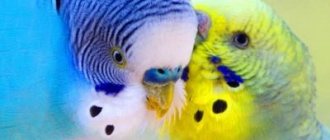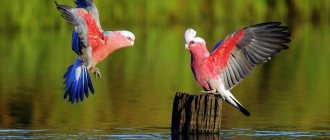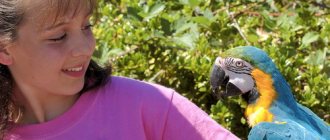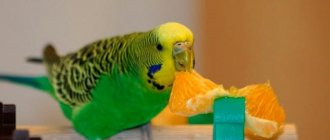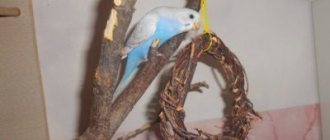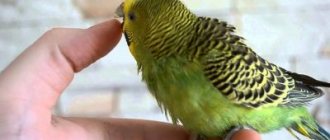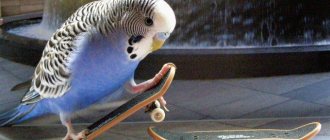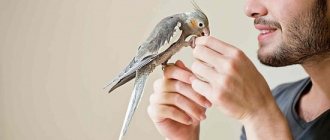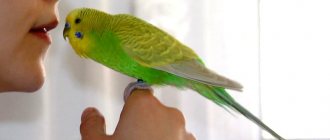- home
- Parrot
- FAQ
05/22/2019 When a pet lives at home, a person makes sure that he is in order both physically and mentally. In order for your poultry to feel good, you need to find time during the day to play with your parrot.
Playing with a bird is an interesting and exciting activity that will bring the owner and pet closer together. Moreover, birds and humans can have fun in different ways.
The benefits and benefits of playing with parrots
In the wild, most of the birds' day is spent searching for food. In captivity, this task is reduced to a minimum, leaving a lot of “free time”. This makes the parrot bored, which, in turn, leads to the development of behavioral defects: screaming, feather plucking, aggressiveness, and other health problems. Therefore, the bird must be provided with a mandatory minimum of physical and mental activity. In addition, in their natural environment, birds also entertain each other by playing. Scientists zoologists, observing their behavior, came to the conclusion that games are the second type of natural activity after searching for food.
Did you know? It has been noticed that games are needed not only by parrots, but also by other birds. Our ordinary crows, for example, in winter can roll down a slope on a piece of tree bark.
Among the main ones:
- object manipulation;
- balancing games;
- acoustic;
- social games.
The latter include scenarios such as “chase me,” “I want to play with what you’re playing with,” and “let’s pretend to fight.” Fighting in the game usually involves beak fencing, kicking, or pinching the legs and feathers of a playmate. For older birds, mock fighting helps them stay in shape and be ready to repel attacks from predators.
To help beginner players
For most joint entertainment, it is necessary that the parrot is not afraid of the owner. The more he trusts a person, the more fun it is to spend time with him.
The parrot may not immediately understand the rules of the game. He may also not be in the mood to play today, but change his mind tomorrow. It makes sense to repeat attempts several times, but avoid being too intrusive.
Parrots have different tastes. What one person likes may not necessarily be liked by another. It is advisable to observe your pet and pay attention to what attracts him. This way you can find out what games he likes.
Irritation has no place in joint entertainment. Parrots are sensitive natures, and showing dissatisfaction can discourage them from playing.
When playing with a parrot, there is no need to remain silent. It’s better to talk to him, praise him, express delight, laugh. This shows how friendly and cheerful the owner is and inspires the bird.
What toys can be used
Interacting with a toy not only stimulates the mind, but also keeps you physically active. In nature, all birds are active. Therefore, sitting in a cage on a perch all day is not only unnatural, but also harmful. And if you cannot pay attention to your pet, then he should have something to cheer himself up with.
Did you know? Chewing activities keep the beak in working order, and physical activity keeps the muscles, tendons and bones strong. In addition, exercise burns calories and prevents you from gaining weight.
Pet stores offer a wide range of toys. Prefer those made from natural materials such as wood and hemp rope. The idea is that the toys can be explored, chewed, crushed, and extracted from them. Therefore, many owners believe that it is enough to provide the parrot with a couple of boxes and other utilitarian items. But this is not always correct.
Toys should be divided into 7 types.
You will be interested in learning how to teach a parrot to talk.
The main ones will be:
- Tree branches. They can be used as poles, and can be pecked and broken in the process. For most species, this takes up a lot of free time. The exception is the macaw - they don't really like to play with branches.
- Swings and stairs. They can be made from any rope. This reminds your pet of the vines in his native jungle and he will love swinging on them.
- Pieces of cardboard boxes, bark, resinous parts of wood. It is especially interesting if there is something inside these objects that attracts the parrot's attention, such as food. This forces owners to do unscheduled cleaning, but it is incredibly exciting for the pet. The simplest such toy is a piece of food wrapped in toilet paper. Grays and cockatiels love such games the most.
- Puzzle toys. They are necessary for all parrots without exception. This could be a bolt inserted into a piece of corrugated cardboard, a button, or other small object.
- Braided balls. The idea is based on the basic instincts of parrots. They love to find insects in tree bark. Therefore, they will be happy to extract what is put into the wicker.
- Pieces of toys, wood, thick rope, rubber, bottle caps, plastic straws. Birds love to explore new textures and these items will provide that opportunity while keeping their attention for a long time.
- Rattles, bells, a ball in a glass bottle. These are all things that make noise that will interest the parrot.
Create a playground for your pet
An owner, puzzled by the all-round development of a feathered pet, may be puzzled by creating a playground for it. Such an area is absolutely necessary for those who spend a lot of time at work, which is why the bird is left to its own devices. When creating a play area for your budgie, it can be placed both inside and outside the cage.
To build a platform that is truly interesting for birds, you need to follow a certain plan:
- draw a design layout;
- describe which available means and in what quantities will be useful;
- prepare the necessary parts;
- take care to carefully secure the parts.
Manufacturers who have created similar platforms more than once recommend using pieces of plywood to secure parts of the structure. They will serve as a kind of pallet, covering which with paper, the owner will save himself from further painstaking cleaning of the pet’s excrement in the play area.
How to play with a parrot
All games include a verbal command given before they begin. This way you make it clear that it is time to play. Not every parrot will want to have fun with the games listed above or others. Be respectful of your pet's individuality and offer him other activities. Some will undoubtedly interest him.
Find out why the parrot stopped flying.
Train the bird to bring the object back to you. Keep throwing the ball towards the parrot until he understands that he must return it to you. Praise in an enthusiastic voice and stroke the feathers on his head. This should consolidate the experience gained and give the pet satisfaction from its actions.
Some parrots enjoy the same games as dogs. You can throw them a small ball or soft toy and say, “Catch it!” If you're lucky, the pet will pick it up with its beak. In this case, he needs to be praised verbally, “Good bird!” and you can offer a treat.
Hide and seek
Go with the parrot to a part of the room where it has never been. Place him at one end of the room and out of sight. Say: "Find me!" After a couple of minutes, look out of the hiding place so that the parrot can see you. Stand far enough away that he needs to fly. If you are friendly enough with your pet, he will look for you and, when he sees you, he will be happy. If you are found, praise him enthusiastically, “Great job!” and stroke the feathers.
Did you know? Like most birds, parrots have four toes. But unlike others, the parrot has 2 fingers in front and 2 in back, which allows it to hold on to branches incredibly tenaciously and at almost any angle. Combined with its sharp beak, this makes it a formidable eater and agile climber.
"Sing and Dance"
This is the simplest trick of all. Select suitable dance music and turn it on. Start dancing. The pet will watch this with great interest and will usually eventually join in. A parrot's dance involves bobbing its head and stepping from foot to foot on its perch. If necessary, show him videos of other parrots dancing. There are many such videos on YouTube. Cockatoos and loris love to dance and move rhythmically more than others. Budgerigars prefer toys that can be pushed around, like a tumbler doll.
Video: parrot dancing
Whistle
Parrots are naturally interested in various sounds and noises. A radio, TV or record player on is a natural source of attraction for your pet. He can imitate sounds he hears. You can record the sounds he likes and play them periodically. After some time, the pet will have its own playlist. Some owners who know how to whistle may try whistling a tune that the parrot likes. And if you're lucky, you'll end up with an interesting duet.
Important! Be careful not to leave frayed cords, broken plastic or other dangerous objects within your pet’s reach. This can lead to injury to the curious parrot.
Water games
Rainfall is beneficial for birds and is not much different from what they experience in nature. Therefore, although parrots do not need to swim, they love to watch you take a shower or brush your teeth. Some individuals try to get under the shower stream. Macaw owners claim that their pets may even persistently knock on the bathroom door if they hear splashing water.
Other parrots love to get their toys out of the water. To do this, you need to take a bowl of water and throw one of them there. The pet will definitely pull her out. This game may involve throwing several toys into the water in turn. It continues as long as the parrot is interested in the activity.
"Get the treat"
In their natural environment, birds need to forage for food. It usually lies on the ground or hangs from a branch. Some types of food require effort to get to. If you hide your favorite treat in a matchbox, a wicker ball, or insert it inside a piece of rubber, your pet will happily begin to get it. This will give him an extra dose of vitamins and a boost of energy.
Mimicking
The owner needs to repeat the parrot's movements and sounds. If it chirps or whistles, then try to reproduce something similar. If he is hammering his beak on a piece of wood, then knock in the same way. If he flaps his wings or his head, then copy these body movements. The hands act as wings. When the parrot understands that this is a game of repetition, the owner can be the first to do something, and the feathered pet can repeat. It is advisable to understand a little bird sign language so as not to accidentally portray something unfriendly. A confident parrot may peck in response.
A variation of this entertainment is winking. The owner winks at the parrot, and the parrot winks back. Some pets love this game.
Another option is dancing to music. You need to turn on a rhythmic song, sing along and not dance too energetically. Parrots usually love music and will begin to move and chirp.
Acrobatic exercises
Some birds easily perform acrobatic stunts, for example, crawling through an improvised tunnel, raising their wings up, or turning over on their side or back. The owner must encourage the active actions of the bird in every possible way. For example, offering your pet a swing, ropes or ladders to climb up.
All this is just a small part of the existing games! The main thing is not to forget that training with a parrot should be with two-way communication
It is very important to give your pet the opportunity to show which games he likes and which ones make him nervous.
Always be receptive to your pet's playful mood. If he doesn’t want to study at the moment, it’s better to just sit quietly with him, talk to him, or read a book out loud to him.
Homemade devices
Often the parrot shows interest in homemade rope ladders, wooden walkways, steps, and swings. Their turn comes when purchased products become boring and no longer attract the feathered fidget. You can make new toys yourself.
How to choose materials to create fun gadgets
Budgerigars are susceptible to limb injuries and poisoning, so the materials from which toys for him will be made must be safe.
The following materials cannot be used:
- Cotton. It crumbles easily, and the bird can get entangled in the threads or swallow some of them. This leads to blockage of the esophagus and the death of the feathered pet.
- Metal products made of brass, copper, zinc. They are toxic to budgies. Also, you cannot use scraps of chains and dismountable metal products with small parts.
- All non-fruit tree species. They are often toxic to poultry. Apple, cherry, plum, and oak are suitable for making toys for a parrot.
